This was published 2 years ago
Avoid dodgy tourist traps: Where to eat near Europe’s top attractions
By Oliver Smith
We’ve all done it. That tiresome slog through a crowded city centre, hunger pangs in the stomach and a morning’s sightseeing in the legs, looking for a restaurant that won’t disappoint.
You search for red flags on the menu. Is it absurdly long? Are there photographs of the food? Is the local speciality inexplicably absent?
You scan the clientele. Are they in-the-know workers on their lunch break or other clueless tourists? Is that regret you can detect in their facial expressions?
You examine the demeanour of the staff. Do they look proud to be working there, or are they scruffy teenagers displaying all the enthusiasm of a prisoner on death row?
“Let’s try one more,” you tell your partner, in the vain hope that the next restaurant will be the one: an unexpected gem in the tourist quarter serving tasty, authentic dishes at reasonable prices — a diamond in the rough.
It needn’t be like this. It’s possible to have a memorable meal even in the shadow of a famous attraction. Here are some of the best dining options a stone’s throw from Europe’s biggest tourist traps. - Oliver Smith
Contributors: Rodney Bolt, Sally Davies, Fiona Flores-Watson, Jane Foster, Ben Groundwater, Anne Hanley, Rachel Howard, Brian Johnston, Linda Macdonald, Lee Marshall, Hannah Meltzer, Nicky Swallow, Alison Taylor
Osteria San Marco, Venice – metres from St Mark’s Square
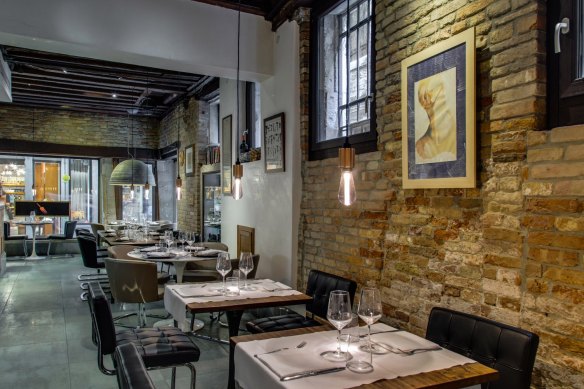
Osteria San Marco, Venice.
The area around San Marco is full of bland, overpriced touristy restaurants. The Osteria San Marco is a rare exception – an oasis of quality in a sea of menù turistici, a good-looking contemporary osteria with a simple but creative seasonally changing menu (pacchetti pasta with prawns, aubergine and liquorice butter, duck breast with paprika and acacia honey) and a serious, well-priced wine list, including several by-the-glass options. Another good thing about this place is their all-day dining policy: you can eat here in the middle of the afternoon if that’s your thing.
Armando al Pantheon, Rome – moments from the Pantheon
This friendly and delicious family-run trattoria is within shouting distance of the Pantheon. Its single room has been sympathetically modernised, keeping original details such as the stained-glass vestibule. Roman classics like spaghetti alla carbonara or juicy sweetbreads rub alongside lighter fare (in spring and summer, don’t miss the asparagus tagliolini). Unusually for a Roman trattoria, they also have several vegetarian and gluten-free options. The wine list is another revelation, offering a serious panorama of some of Italy’s best small- and medium-scale producers, and the mark-ups are reasonable.
Proto, Dubrovnik – right on the Stradun
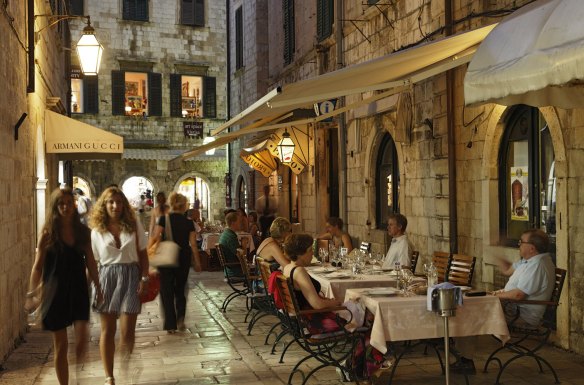
Credit: Alamy
An old-fashioned and romantic establishment that dates back to 1886. The best tables are on a leafy first-floor covered terrace, plus there’s a ground-floor dining room and tables on the street out front. It is widely regarded as the best fish restaurant in Dubrovnik, and specialises in classy Dalmatian seafood. You can indulge in fresh oysters from Ston, škampi na buzaru (shrimps in garlic, white wine and parsley) and whole fresh fish, served filleted. Recent illustrious customers include US film director Francis Ford Coppola and NBA legend Michael Jordan.
Rijks, Amsterdam – underneath the Rijksmuseum
Star chef Joris Bijdendijk glitters in this small restaurant found beneath the Rijksmuseum. There is a delicate, sophisticated touch given to his dishes: wild duck with sweet-and-sour fennel; pumpkin, aromatic with fresh porcini and hazelnut. This is by far the best cuisine to be had near the big museums, and well worth a special lunchtime treat. As befitting a restaurant at the national museum, Bijdendijk sources mainly local and traditional products. Try one of the Dutch white wines such as Apostelhoeve Riesling – they are surprisingly good.
Mamarracha, Seville – in the shadow of the cathedral
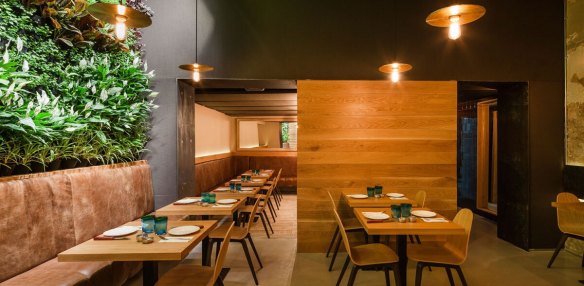
Credit: Fernando Alda
This slick joint, steps from the cathedral, is a favourite with groups of friends; the industrial chic vibe – with its vertical garden and concrete walls – appeals to the more forward-thinking sectors of Seville society. The speciality here is grilled meat (leg of lamb or Iberian pork loin) but there’s plenty for fish lovers such as barbecued sardines and razor clams with lime and coriander mayo. A short but select sherry list includes crisp Papirusa manzanilla, while Tetas de la Sacristana is a new-generation Andalucian red, a soft, elegant tempranillo from the eastern Alpujarra mountains.
Can Culleretes, Barcelona – just off La Rambla
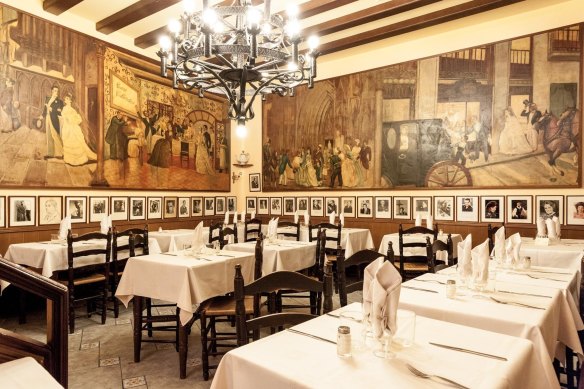
Credit: Can Culleretes
The second-oldest restaurant in Spain, with a mention in Guinness World Records, Can Culleretes has been around since 1786, and many of its waitresses act like they have too. These redoubtable matrons chivvy customers into one of three main dining rooms, tiled and hung with oil paintings and photos of happy patrons, and then serve them no-nonsense but tasty Spanish dishes at really good prices. Try the wild boar stew, the partridge or the seafood ‘pica pica’ of plates to share. It can get busy with tourists, however, so you might want to book a later table.
Saita, Athens – in the shadow of the Acropolis
A rare exception to the uninspired, overpriced restaurants that line the touristy alleys of Plaka, this classic koutouki (basement tavern) is a delicious slice of Athenian history. Wooden wine barrels line the cosy downstairs dining room, overlooking a tiny kitchen where cheery chefs whip up Greek classics such as soutzoukakia (meatballs in a cumin-scented tomato sauce), baked aubergines, and wilted greens doused in lemon and olive oil. The tables on the marble-paved street offer a colourful parade of passers-by, where diners are often serenaded by buskers on bouzoukis or a chanting priest in the Byzantine chapel next door.
Osteria Vini e Vecchi Sapori, Florence – steps from the Uffizi
It may be steps from the Uffizi, one of the city’s biggest tourist draws, but this ever-crowded squeeze of a restaurant with bare wood tables and memorabilia-stacked walls, has many local fans; the ‘no pizza, no cappuccino, no ice, no takeaway’ confirms that it hasn’t sold its soul. Exemplary classics such as hearty ribollita, pappardelle pasta with duck sauce, ‘peposo’ (a black pepper-spiked stew), baccalà alla Livornese (salt cod in tomato sauce) and sizzling deep-fried courgette flowers are served by cheerful, chatty waiters and there’s a lovely little terrace right on Piazza della Signoria for summer meals.
Café de la Paix, Paris – beside the Palais Garnier
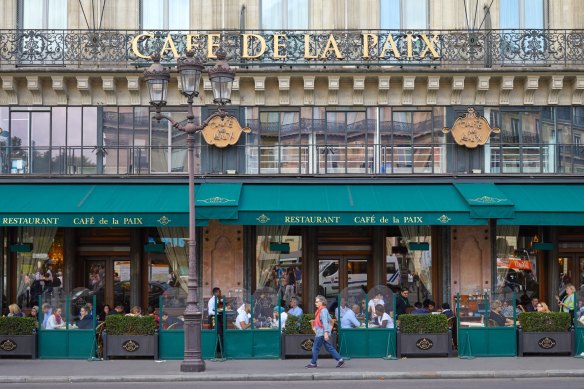
Credit: Alamy
Occupying a whole city block in the shadow of the Palais Garnier opera house, Café de la Paix offers grand old-school Parisian dining par excellence. The restaurant opened in the 1860s and is one of the French capital’s most iconic dining spots, and was once frequented by the likes of Emile Zola, Oscar Wilde and Ernest Hemingway. The menu offers French gourmet classics — think luxurious seafood platters piled high with oysters and prawns, or steak served with green beans and puréed potatoes. There’s décor to match with the opulent restored Second Empire décor.
The Wolseley, London – a stone’s throw from Piccadilly Circus
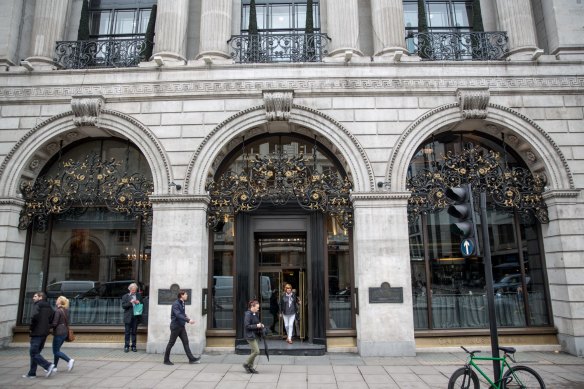
Credit: Ben Peter Catchpole / Alamy
European brasserie dining on a grandiose scale. The Piccadilly site used to be a very posh car showroom of the same name, and the revered atmosphere lives on – you can’t help but let out a little gasp when the ornate room swallows you up. Even though The Wolseley hasn’t been around that long it feels very traditional and comforting. It’s a place for regulars, and low-key celebrities and media people having breakfast meetings, but don’t let that put you off. Whatever time of day you come it feels like an event, and the staff treats you like it’s your birthday even if it isn’t. The menu is full of comforting crowd pleasers from across Europe - like eggs Benedict, coq au vin with creamed mash and black forest gateau.
The Witchery by the Castle, Edinburgh – on the Royal Mile
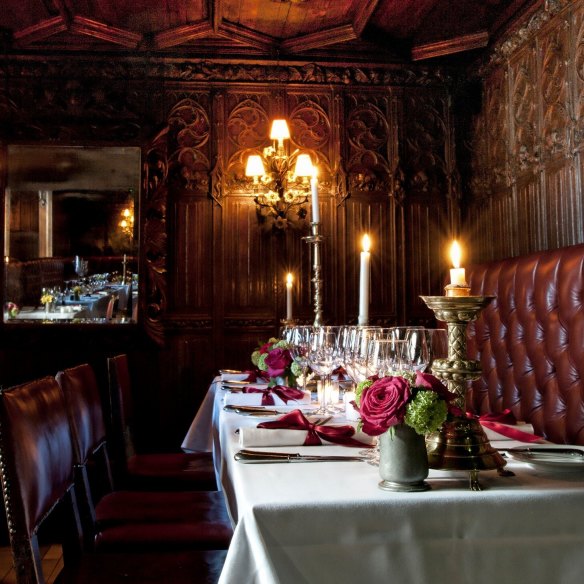
Credit: The Witchery
As much a destination as a place to eat, this outrageously theatrical restaurant at the top of the Royal Mile looks like a hectic cross between a church and a bordello – all lush leather and gilding, tapestries and oak carving. If you like your décor just as romantic but a little less darkly gothic, ask for a table in the Secret Garden. It’s not necessarily the best cooking in Edinburgh, but it is (mostly) reliably Scottish (roast loin of Cairngorm venison), if occasionally slightly worrying (Witchery haggis, curried pineapple), and the service is as polished as the brass candlesticks.
Arca, Amsterdam – close to Centraal Station
A hidden (literally: you can’t see it from the street) gem near Centraal Station – an area otherwise arid of good restaurants. Arca sits between an open kitchen and a large open hearth, in the depths of the designer-savvy Art’otel. Under the guiding hand of Portuguese culinary supremo Henrique Sà Pessoa, chef Ricardo Pereira comes up with combinations that both astonish and delight (scallops with pumpkin soup, the flavours bridged with lemongrass and hints of chili), and traditional ingredients taken on adventures influenced by Portugal’s ancient trade routes (succulent pork cheek, marinated with coriander, cloves and cinnamon and slow-cooked for three hours).
Pasteis de Belem, Lisbon – a short walk from Torre de Belem
Here’s one of those rare classics that actually lives up to the hype. Pasteis de Belem would have to be the most famous “pastel de nata”, or Portuguese tart, shop in all of Portugal, so you go there with a measure of suspicion, particularly when you see the tour buses out the front and the huge queues of tourists who have wandered over from famous sites such as Torre de Belem and the Padrao dos Descobrimentos. You fight to get a seat, you yell your order to someone, and then the most delicious little custard tarts you have ever eaten in your life arrive on your table.
Lamucca de Prado, Madrid – a stone’s throw from the Museo del Prado
This should not be a good place to eat. Lamucca de Prado has all the hallmarks of a tourist trap: it’s a large venue, set over two floors; it’s part of a chain of four restaurants owned by the same company, who took over this space from the iconic Café del Prado; its menu has an “international” influence; and Lamucca is concerningly close to the Museo del Prado, one of Europe’s best art galleries. And yet it’s actually fantastic, particularly if you’re up for a break from the patatas bravas norm, with plenty of interesting tapas options in a friendly environment.
Biergarten am Chinesischen Turm, Munich – right in the famous Englischer Garten
Any other country, this would probably be a little tacky. Beer gardens typically aren’t places of high culture, not somewhere you would visit to indulge in a local rite. So as you wander through Munich’s gorgeous Englischer Garten, or English Garden, you might be tempted to ignore all the wooden bench seats and long trestle tables set around the “Chinese Tower”, a pagoda at the park’s southern end. That, however, would be a mistake, because this is a Munich icon, a beer garden that is just as popular with local students as anyone else, where the beer is cold and plentiful, and the sausages and potato salad delicious. Can’t go wrong.
Plachuttas, Vienna – one minute from the opera house
Chic restaurant Plachuttas Gasthaus zur Oper is pleasantly informal and eschews Austrian kitsch for a sleek contemporary look. Dine early before an evening at the State Opera. The focus is modernised versions of traditional Viennese cuisine, such as Tafelspitz (boiled beef) or roast pork with white bread dumplings, accompanied by beer from Vienna’s Ottakringer brewery. The crisp veal schnitzel accompanied by potato salad sits multiple levels above the tired Australian pub favourite. Save room for Kaiserschmarrn, a chopped pancake served with a dusting of icing sugar and stewed plums.
Castelroc, Monaco – across the square from the palace
If Prince Albert II peered out a window he could see this unpretentious Monegasque restaurant across the square; indeed, he must do on occasion, since he’s known to drop in for cod stew. No random international tourist menu here, but rather a resolute focus on rustic local cuisine such as octopus stewed in wine, pissaladière (a type of pizza topped with sardines and caramelised onion), and ravioli-like pasta stuffed with ricotta and spinach called barbajiuan. The restaurant has been family run since opening in 1953. You can bag an excellent two-course lunch for 29 euros ($47).
Great places to eat within major attractions
Restaurante Parador de Granada in the Alhambra, Granada
The restaurant at this 15th-century convent-turned-hotel is right inside the Alhambra palace complex, with views from its terrace over the cedar trees, rose beds and whitewashed pavilions of Generalife gardens. The menu highlights Muslim-influenced Andalusian dishes such as gazpacho, orange salad, broad beans with ham, monkfish in romesco sauce, and syrupy sponge cakes. See paradores.es
Do & Co in the Albertina Museum, Vienna
When you need a break from Durer, Cezanne, Klimt and Picasso drawings, get fresh air, coffee and nougat dumplings on this restaurant terrace with its Burggarten views, or lunch in the leather-and-marble interior. The reasonably priced fare is light and Mediterranean: grilled cod with eggplant, Turkish meatballs, pasta with braised oxtail ragu. See doco.com
Ore Ducasse in Versailles palace, Paris
With its floor-to-ceiling windows overlooking the Cour Royale and Cour d’Honneur, this café could hardly have a more touristy location, but with gastronomic giant Alain Ducasse’s name attached you can be sure of excellent service and food. Expect light cafe fare, classic French dishes and irresistible pastries; you can even get breakfast and afternoon tea. See chateauversailles.fr
Dining Hall at the National Museum, Stockholm
Leading Swedish designers contributed the lights, furnishings, crockery and glassware here, and the ingredients are nearly all Swedish too, although appearing in dishes that lean towards Italy and France (chicken in white wine, fish casserole, duck confit). If you’re only after a snack, head to Glass Bar and Cafe for Baltic herring, sandwiches, pastries and Swedish craft beers and spirits. See nationalmuseum.se
Jose Pizarro at the Royal Academy, London
You won’t find better tapas this side of Spain then at this swish but informal eatery at the Royal Academy of Arts, where your palate will be dancing the fandango from the moment you eat an orange-stuffed olive, simple shrimp doughnut dipped in lemon aioli, or confit leeks with anchovy. Even the ho-hum ham-and-cheese sandwiches, tomato bruschetta and cheesecake are transformed. See royalacademy.org.uk
LE JULES VERNE, EIFFEL TOWER, PARIS
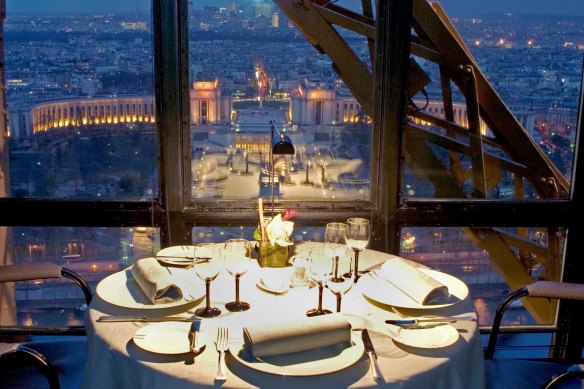
Le Jules Verne offers more than just a great location.Credit: Alamy
You have to assume that the French author Guy de Maupassant – who famously ate his lunch at the base of the Eiffel Tower every day, to avoid having to look at what he considered an eyesore – would have enjoyed dining at Le Jules Verne. This restaurant sits on the second floor of France’s most famous monument, but it offers far more than just location: this is a beautiful eatery where stylish, modern French fare is served with panache.
NERUA, GUGGENHEIM, BILBAO
Where does the art end and the food begin? That’s something you will have cause to ponder at Nerua, the Michelin-starred fine-dining restaurant set within the flowing waves of the Frank Gehry-designed Guggenheim Museum Bilbao. And the truth is that the art doesn’t end, because it’s there on your plate, in modern Basque cuisine that is presented with an artist’s eye for beauty.
RESTAURANT SPHERE, TV TOWER, BERLIN
From almost anywhere in Berlin you can see one of its most famous buildings: the Berliner Fernsehturm, otherwise known as the TV Tower in Alexanderplatz, the highest publicly accessible building in Europe. And up there, 207 metres above Berlin, there’s Sphere, a revolving restaurant where the food demands as much attention as the views. A visit here is memorable for all the right reasons.
tv-term.de
LYSVERKET, KODE, BERGEN
Only 14 restaurants in the whole of Norway can boast a Michelin star, and one of them is Lysverket, set within Kode, a modern art museum in Bergen featuring works by the likes of Pablo Picasso, Edvard Munch and Paul Klee. The food at Lysverket is worthy of those famous names, modern Nordic cuisine utilising seasonal, local produce in ways that are creative and skilful. No wonder it’s so popular.
lysverket.no
OBLIX, THE SHARD, LONDON
There are few views in London to rival those from the Shard, and there’s no shortage of restaurants and bars within the British capital’s most famous skyscraper taking advantage of that fact. Probably the best of them is Oblix, a New York-style diner on the 32nd floor that serves high-end steaks and other grilled meats, paired with views of London that sprawl as far as the eye can see.
The Telegraph, London, with Traveller
Sign up for the Traveller Deals newsletter
Get exclusive travel deals delivered straight to your inbox. Sign up now.